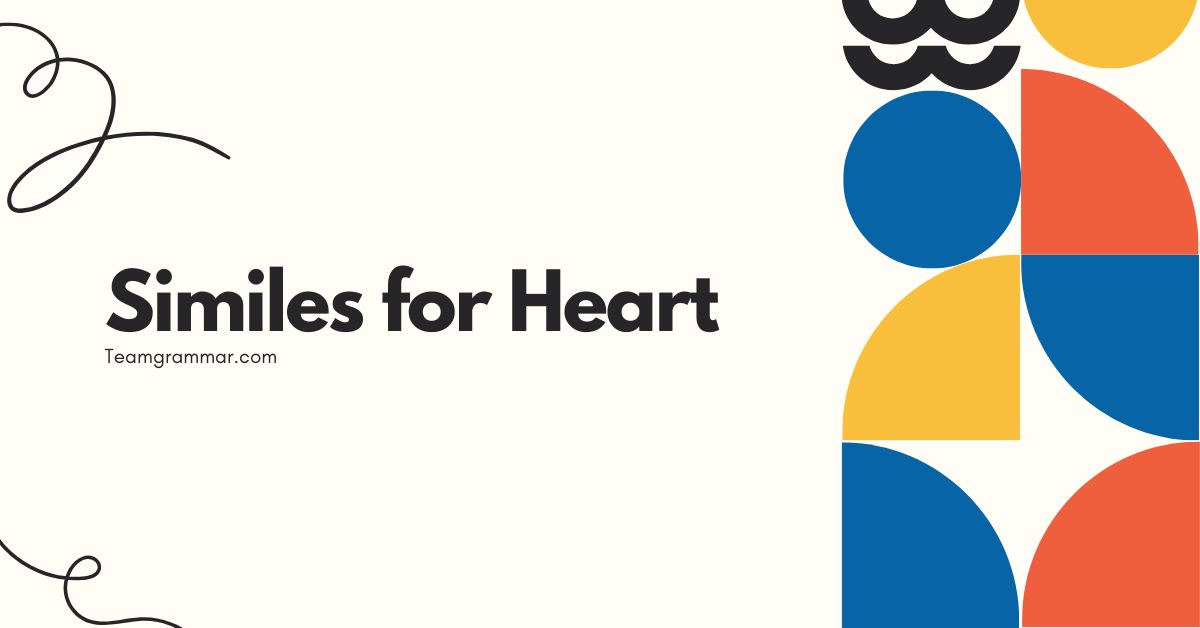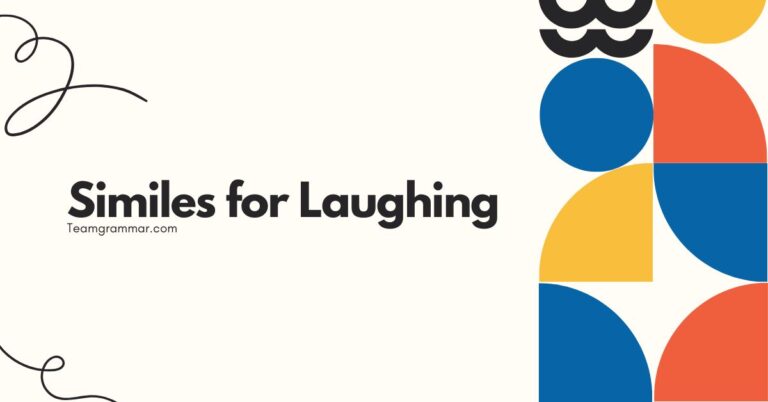43 Similes for Heart: A Comprehensive Guide to Figurative Language
Understanding similes is crucial for enhancing your writing and comprehension skills. Similes, which use “like” or “as” to compare two unlike things, add vividness and depth to language.
This article provides a detailed exploration of similes related to the heart, a symbol rich with emotional and metaphorical significance. Whether you’re a student, writer, or English enthusiast, this guide will equip you with the knowledge and practice to master this aspect of figurative language, enabling you to express yourself more creatively and effectively.
Table of Contents
- Introduction
- Definition of Simile
- Structural Breakdown of Similes
- Types of Heart Similes
- Examples of Similes for Heart
- Usage Rules for Heart Similes
- Common Mistakes with Similes
- Practice Exercises
- Advanced Topics in Similes
- FAQ Section
- Conclusion
Definition of Simile
A simile is a figure of speech that compares two unlike things using the words “like” or “as.” Its primary function is to create a vivid image or convey a specific feeling by drawing a parallel between two distinct concepts. Similes are a fundamental tool in descriptive writing and are used extensively in literature, poetry, and everyday language to enhance understanding and evoke emotion.
Similes are classified as a type offigurative language, which means they use words or expressions with a meaning that is different from the literal interpretation. This allows for a more creative and impactful way to communicate ideas.
The effectiveness of a simile lies in the unexpected yet relatable comparison it makes, prompting the reader or listener to see something in a new light.
The context in which a simile is used is crucial. The appropriateness of a simile depends on the tone, audience, and overall purpose of the communication.
A well-chosen simile can elevate writing, making it more engaging and memorable. Conversely, a poorly chosen simile can be confusing or detract from the intended message.
Structural Breakdown of Similes
The basic structure of a simile involves three key elements: the two unlike things being compared, and the connecting word, which is either “like” or “as.” Understanding this structure is essential for creating and interpreting similes effectively. The comparison highlights a shared characteristic between the two unlike things.
Let’s break down the structure with an example: “Her heart was like a stone.”
- Thing 1: Her heart
- Connecting Word: like
- Thing 2: a stone
In this simile, the heart is being compared to a stone. The shared characteristic might be hardness, coldness, or lack of emotion.
The word “like” establishes the comparison, indicating that the heart shares a quality with the stone, but is not literally a stone.
Another example: “His heart beat as fast as a hummingbird’s wings.”
- Thing 1: His heart
- Connecting Word: as
- Thing 2: a hummingbird’s wings
Here, the heart’s rapid beating is compared to the fast movement of a hummingbird’s wings. The word “as” serves the same function as “like,” creating a comparison based on speed and intensity.
Recognizing this structure allows you to deconstruct and understand any simile you encounter.
Types of Heart Similes
Similes for the heart can be broadly categorized into three types based on the aspect of the heart they emphasize: emotional, physical, and metaphorical. Each type serves a different purpose and evokes different imagery.
Emotional Heart Similes
Emotional heart similes describe the heart in terms of its emotional state. These similes often relate to feelings such as love, sadness, joy, fear, or anger.
They help to convey the intensity and nature of these emotions by comparing the heart to something that embodies those feelings.
Examples include:
- Her heart was like a deflated balloon after the breakup.
- His heart felt as heavy as lead with grief.
- Her heart soared like a kite with happiness.
Physical Heart Similes
Physical heart similes describe the heart in terms of its physical characteristics or actions, such as its beating, size, or condition. These similes often relate to health, vitality, or the effects of physical exertion or stress.
They help to create a tangible image of the heart’s physical state.
Examples include:
- His heart pounded like a drum during the race.
- Her heart felt as fragile as glass after the surgery.
- His heart skipped a beat like a scratched record.
Metaphorical Heart Similes
Metaphorical heart similes describe the heart in abstract or symbolic terms. These similes often relate to the heart as the center of emotions, courage, or personality.
They help to convey deeper meanings and insights about the heart’s role in human experience.
Examples include:
- Her heart was like a compass, always guiding her home.
- His heart was as cold as ice towards his enemies.
- Her heart was an open book, revealing her true feelings.
Examples of Similes for Heart
This section provides extensive examples of similes for the heart, organized by the categories discussed above: emotional, physical, and metaphorical. Each category includes a variety of examples to illustrate the different ways in which similes can be used to describe the heart.
Emotional Examples
The following table presents examples of emotional heart similes, illustrating how the heart can be compared to other things to express feelings like love, sadness, and joy. These similes help to convey the intensity and nuance of emotional experiences.
| Simile | Explanation |
|---|---|
| Her heart was like a blooming rose when she saw him. | Expresses the joy and beauty of love. |
| His heart felt as heavy as a stone after the loss. | Conveys the burden and weight of grief. |
| Her heart fluttered like a butterfly when he kissed her. | Illustrates the nervous excitement of new love. |
| His heart was like a deflated balloon after the rejection. | Shows the disappointment and emptiness of rejection. |
| Her heart soared like an eagle when she achieved her goal. | Expresses the exhilaration and freedom of success. |
| His heart was as cold as ice towards his betrayers. | Conveys the bitterness and resentment of betrayal. |
| Her heart was like a ticking time bomb with anxiety. | Illustrates the growing tension and fear of anxiety. |
| His heart felt as light as a feather with relief. | Shows the release and lightness of relief. |
| Her heart was like a fragile bird in his hands. | Expresses vulnerability and the need for care. |
| His heart burned like a furnace with passion. | Conveys the intensity and heat of desire. |
| Her heart was like a wellspring of love for her children. | Illustrates the boundless and nurturing nature of maternal love. |
| His heart felt as hollow as a drum after she left. | Shows the emptiness and lack of purpose after loss. |
| Her heart danced like a flame in the wind with excitement. | Expresses the unpredictable and joyful nature of excitement. |
| His heart was like a locked box, guarding his secrets. | Conveys the guardedness and protection of secrets. |
| Her heart was as soft as velvet towards those in need. | Illustrates the compassion and empathy for others. |
| His heart felt like a clenched fist with anger. | Shows the tension and control of anger. |
| Her heart was like a beacon of hope in the darkness. | Expresses the guiding and reassuring nature of hope. |
| His heart was as heavy as lead with guilt. | Conveys the burden and weight of guilt. |
| Her heart was like a delicate flower, easily bruised. | Illustrates the fragility and vulnerability of emotions. |
| His heart pounded like a hammer with fear. | Shows the intense physical reaction to fear. |
| Her heart was as light as air with anticipation. | Expresses the joyful expectation of something to come. |
| His heart was like a shield, protecting him from pain. | Conveys the defensive and protective nature of emotional barriers. |
| Her heart was like a gentle stream, flowing with kindness. | Illustrates the consistent and soothing nature of kindness. |
| His heart was as wild as a storm with rage. | Shows the uncontrolled and destructive nature of rage. |
Physical Examples
The following table presents examples of physical heart similes, illustrating how the heart can be compared to other things to describe its physical state or actions. These similes help to create a tangible image of the heart’s physical condition.
| Simile | Explanation |
|---|---|
| His heart beat like a drum during the marathon. | Expresses the strong, rhythmic beating of the heart during exercise. |
| Her heart felt as fragile as glass after the surgery. | Conveys the vulnerability and delicacy of the heart after a medical procedure. |
| His heart skipped a beat like a scratched record when he saw her. | Illustrates the sudden, irregular rhythm of the heart caused by surprise or attraction. |
| Her heart pounded like a hammer in her chest before the presentation. | Shows the forceful, rapid beating of the heart due to anxiety. |
| His heart felt as heavy as lead after the diagnosis. | Expresses the burden and weight on the heart due to bad news. |
| Her heart raced like a hummingbird’s wings when she ran up the stairs. | Conveys the rapid, fluttering beating of the heart during physical exertion. |
| His heart felt as though it would burst like a balloon with excitement. | Illustrates the intense pressure and overwhelming sensation of excitement. |
| Her heart fluttered like a trapped bird in her chest when he proposed. | Shows the nervous, erratic beating of the heart caused by anticipation and joy. |
| His heart felt as cold as ice after years of neglect. | Expresses the weakened, unresponsive state of the heart due to poor health. |
| Her heart pumped like a well-oiled machine during her workout. | Conveys the efficient, strong functioning of the heart during exercise. |
| His heart felt as if it were shrinking like a raisin with sadness. | Illustrates the diminished, weakened state of the heart due to sorrow. |
| Her heart beat as steadily as a clock after meditation. | Shows the calm, regular rhythm of the heart after relaxation. |
| His heart felt as though it were made of stone, unyielding to emotion. | Expresses the hardened, unresponsive state of the heart due to emotional trauma. |
| Her heart felt as light as a feather after forgiving him. | Conveys the relief and lightness felt by the heart after forgiveness. |
| His heart felt as though it were being squeezed like a lemon with stress. | Illustrates the pressure and constriction felt by the heart due to stress. |
| Her heart beat as strongly as a lion’s roar with determination. | Shows the powerful, forceful beating of the heart fueled by determination. |
| His heart felt as though it were cracking like a dry leaf with grief. | Expresses the fragile, broken state of the heart due to grief. |
| Her heart felt as warm as sunshine after spending time with loved ones. | Conveys the comforting, revitalizing effect of love and connection. |
| His heart felt as though it were drowning like a sinking ship with despair. | Illustrates the overwhelming, hopeless sensation of despair. |
| Her heart beat as rhythmically as a metronome during her yoga practice. | Shows the consistent, measured rhythm of the heart during relaxation. |
| His heart felt as though it were being pierced like a sword with pain. | Expresses the sharp, intense sensation of emotional pain. |
| Her heart felt as energetic as a battery after a good night’s sleep. | Conveys the revitalized, recharged state of the heart after rest. |
| His heart felt as though it were being crushed like a can with pressure. | Illustrates the overwhelming, debilitating effect of pressure. |
| Her heart beat as gently as a lullaby with contentment. | Shows the soft, soothing rhythm of the heart during contentment. |
Metaphorical Examples
The following table presents examples of metaphorical heart similes, illustrating how the heart can be compared to other things to convey abstract or symbolic meanings. These similes help to express deeper insights about the heart’s role in human experience.
| Simile | Explanation |
|---|---|
| Her heart was like a compass, always guiding her home. | Expresses the heart’s role in providing direction and purpose. |
| His heart was as cold as ice towards his enemies. | Conveys the heart’s lack of warmth and compassion towards adversaries. |
| Her heart was an open book, revealing her true feelings. | Illustrates the heart’s transparency and honesty. |
| His heart was like a fortress, protecting him from vulnerability. | Shows the heart’s defensive and protective nature. |
| Her heart was a garden, cultivated with love and care. | Expresses the heart’s potential for growth and beauty through nurturing. |
| His heart was like a battlefield, scarred by past hurts. | Conveys the heart’s resilience and the marks left by painful experiences. |
| Her heart was a sanctuary, offering peace and refuge. | Illustrates the heart’s capacity to provide comfort and safety. |
| His heart was like a locked diary, filled with unexpressed emotions. | Shows the heart’s tendency to conceal and suppress feelings. |
| Her heart was a wellspring of kindness, always overflowing with compassion. | Expresses the heart’s boundless capacity for empathy and generosity. |
| His heart was like a shattered mirror, reflecting broken images of himself. | Conveys the heart’s fragmented and distorted sense of self after trauma. |
| Her heart was a beacon of hope, guiding others through darkness. | Illustrates the heart’s ability to inspire and lead others towards a better future. |
| His heart was like a tangled web, ensnared by past mistakes. | Shows the heart’s struggle to break free from the consequences of past actions. |
| Her heart was a symphony, playing a beautiful melody of love and joy. | Expresses the heart’s harmonious and uplifting nature. |
| His heart was like a barren desert, devoid of warmth and connection. | Conveys the heart’s emptiness and isolation. |
| Her heart was a treasure chest, filled with precious memories. | Illustrates the heart’s role in preserving and cherishing important experiences. |
| His heart was like a rusty key, unable to unlock his true potential. | Shows the heart’s stagnation and inability to move forward. |
| Her heart was a lighthouse, guiding lost souls to safety. | Expresses the heart’s ability to offer guidance and support to others in need. |
| His heart was like a dark cloud, casting a shadow over his life. | Conveys the heart’s negativity and its impact on one’s overall well-being. |
| Her heart was a tapestry, woven with threads of love, loss, and resilience. | Illustrates the heart’s complex and multifaceted nature, shaped by various experiences. |
| His heart was like a ticking clock, reminding him of his mortality. | Shows the heart’s awareness of time and the urgency of living fully. |
| Her heart was a garden in spring, bursting with new life and possibilities. | Expresses the heart’s potential for growth, renewal, and fresh beginnings. |
| His heart was like an anchor, weighing him down with regret. | Conveys the heart’s burden of past mistakes and the difficulty of moving on. |
| Her heart was a river, flowing with compassion and understanding. | Illustrates the heart’s constant and unwavering capacity for empathy. |
| His heart was like a shattered vase, its beauty forever marred by trauma. | Shows the heart’s lasting wounds and the difficulty of restoring its former state. |
Usage Rules for Heart Similes
Using similes effectively involves understanding certain rules and guidelines. These rules ensure that your similes are clear, impactful, and appropriate for the context.
- Clarity: The comparison should be clear and easy to understand. Avoid obscure or overly complex comparisons that may confuse the reader.
- Relevance: The two things being compared should share a relevant characteristic. The shared characteristic should be the basis of the comparison.
- Originality: While common similes can be effective, strive for originality to make your writing more engaging and memorable. Avoid clichés.
- Context: The simile should be appropriate for the tone, audience, and purpose of the writing. Consider the overall message you are trying to convey.
- Consistency: Maintain consistency in your use of similes throughout your writing. Avoid mixing metaphors or using conflicting imagery.
For example, instead of saying “His heart was like a car,” which lacks a clear shared characteristic, you could say “His heart was like a race car, speeding with excitement,” which clearly conveys the rapid, intense beating of the heart.
Common Mistakes with Similes
Several common mistakes can weaken the effectiveness of similes. Being aware of these mistakes can help you avoid them and improve your writing.
| Incorrect | Correct | Explanation |
|---|---|---|
| His heart was like a heart. | His heart was like a drum. | Avoid comparing something to itself. |
| Her heart was as red as blood. | Her heart was as cold as ice. | Ensure the comparison is meaningful and not stating the obvious. |
| His heart was like a confusing idea. | His heart was like a tangled web. | The comparison should be clear and relatable. |
| Her heart was like a metaphor. | Her heart was like a blooming rose. | Avoid comparing something to an abstract concept. |
Another common mistake is using similes that are clichés. Clichés are overused expressions that have lost their impact.
For example, “His heart was as good as gold” is a cliché. Instead, try something more original: “His heart was as pure as a mountain spring.”
Practice Exercises
Test your understanding of similes with these practice exercises. Fill in the blanks to complete the similes, using your creativity and knowledge of the heart’s various aspects.
| Question | Answer |
|---|---|
| 1. Her heart was as ________ as a feather after the good news. | light |
| 2. His heart felt like a ________ in his chest before the big game. | drum |
| 3. Her heart was like a ________, always guiding her towards the truth. | compass |
| 4. His heart was as ________ as ice after the betrayal. | cold |
| 5. Her heart fluttered like a ________ when she saw him. | butterfly |
| 6. His heart was as ________ as gold, always willing to help others. | generous |
| 7. Her heart was like a ________, overflowing with love for her family. | wellspring |
| 8. His heart felt like a ________, heavy with sorrow. | stone |
| 9. Her heart was like a ________, fragile and easily broken. | glass |
| 10. His heart was as ________ as a lion, brave and strong. | courageous |
More Exercises:
| Question | Answer |
|---|---|
| 11. Her heart was like a ________ in the storm, offering hope and safety. | lighthouse |
| 12. His heart felt as ________ as a feather after forgiving her. | light |
| 13. Her heart was like a ________, beating strong and steady through life’s challenges. | drum |
| 14. His heart was as ________ as a winter night, devoid of warmth and affection. | cold |
| 15. Her heart was like a ________, unfolding its beauty with each passing day. | flower |
| 16. His heart was as ________ as a fortress, guarding his deepest fears and secrets. | impenetrable |
| 17. Her heart was like a ________, always seeking adventure and new experiences. | wanderer |
| 18. His heart felt as ________ as a bird, soaring with hope and freedom. | light |
| 19. His heart was like a ________, resilient and unyielding to despair. | rock |
| 20. Her heart was as ________ as a summer breeze, gentle and refreshing. | soft |
Advanced Topics in Similes
For advanced learners, exploring more complex aspects of similes can further enhance their understanding and usage. This includes understanding the subtle differences between similes and metaphors, and how to use extended similes to create richer imagery.
Simile vs. Metaphor:While both similes and metaphors make comparisons, similes use “like” or “as” to create an explicit comparison, whereas metaphors imply a comparison without using these words.
For example, “Her heart was like a blooming rose” (simile) versus “Her heart was a blooming rose” (metaphor).
Extended Similes:An extended simile is a simile that is developed over several lines or sentences. This allows for a more detailed and nuanced comparison.
For example:
“His heart was like a ship lost at sea, tossed and turned by the waves of despair, with no compass to guide him, and no land in sight, drifting aimlessly in the vast ocean of his sorrow.”
FAQ Section
- What is the difference between a simile and a metaphor?
A simile uses “like” or “as” to make a direct comparison between two things, while a metaphor implies a comparison without using these words. A simile says something is like something else; a metaphor says something is something else.
- Why are similes important in writing?
Similes add vividness, clarity, and emotional depth to writing. They help readers understand complex ideas by relating them to familiar concepts and creating memorable images.
- How can I create more original similes?
To create original similes, think beyond common comparisons and look for unexpected connections between things. Consider the specific qualities you want to emphasize and brainstorm objects or concepts that share those qualities.
- What are some common mistakes to avoid when using similes?
Avoid using clichés, comparing something to itself, making obvious comparisons, and creating confusing or irrelevant comparisons. Ensure your similes are clear, meaningful, and appropriate for the context.
- Can a simile be too complex?
Yes, a simile can be too complex if it is difficult to understand or if the comparison is too obscure. The goal is to enhance understanding, not to confuse the reader.
- How do I choose the right simile for my writing?
Consider the tone, audience, and purpose of your writing. Choose a simile that is appropriate for the context and that effectively conveys the message you are trying to communicate.
- Are similes only used in creative writing?
No, similes can be used in various types of writing, including informative and persuasive writing. They can help to explain complex concepts, add emphasis, and engage the reader.
- How can I improve my simile writing skills?
Practice writing similes regularly, read widely to observe how other writers use similes, and seek feedback on your writing from others. Pay attention to the clarity, relevance, and originality of your similes.
- What is an extended simile?
An extended simile is a simile that is developed over several lines or sentences, allowing for a more detailed and nuanced comparison. It provides a richer and more vivid image.
- How do similes contribute to imagery in writing?
Similes create vivid and detailed mental images by comparing something unfamiliar to something familiar. This helps readers visualize and connect with the writing more effectively, enhancing their understanding and emotional engagement.
Conclusion
Mastering similes is an invaluable skill for anyone looking to enhance their writing and communication abilities. By understanding the structure, types, and usage rules of similes, and by avoiding common mistakes, you can create more vivid, engaging, and impactful writing.
Similes related to the heart, in particular, offer a rich field for exploration, given the heart’s central role in emotions and human experience.
Remember to practice regularly, seek feedback, and strive for originality in your similes. As you continue to develop your skills, you will find that similes become a powerful tool for expressing yourself more creatively and effectively.
Whether you’re writing poetry, prose, or everyday communication, the ability to craft compelling similes will set your writing apart and captivate your audience.







